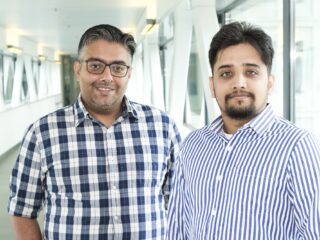The story of the ultra-rare Barakat-Perenthaler syndrome begins in 2017 in a consulting room at the Erasmus MC Sophia. Dr. Stefan Barakat, a physician in the department of clinical genetics, meets a newborn girl with an unexplained developmental delay and very severe epilepsy. After extensive genetic examination was done, results lead to a mutation in the UGP2 gene. This was surprising, given the gene had never been linked to disease before.
It came in handy that, besides working as a physician, Barakat is also head of a research group at the Department of Clinical Genetics. Together with PhD student Elena Perenthaler, he determined that the mutation in the UGP2 gene was indeed the cause of the girl’s developmental delay and epilepsy. The mutation blocks the production of a specific form of the UGP2 protein, which is particularly important in the brain.
The lack of UGP2 protein in the brain leads to the badly treatable epilepsy, severe developmental delay and problems with vision and nutrition. The syndrome, from which children often die at a young age, was given the name of the discoverers: the Barakat-Perenthaler syndrome. As of yet, there is treatment that targets the cause of the problems. The epilepsy can be suppressed with drugs, but this often works poorly.
Tinder for geneticists
But the Clinical Genetics team did not give up. Through what Barakat jokingly calls “Tinder for geneticists” – the website GeneMatcher – the researchers found nearly 40 patients with the same UGP2 mutation and the same clinical picture.
Then they noticed something: almost all the children lived in the Middle East. ‘Eventually we were able to trace all the families back to a common ancestor who must have lived about 600 years ago in the region of Balochistan on the border of Iran, Pakistan and Afghanistan.’ The Dutch girl seemed an oddity at first, until the researchers realized that a Dutch trading post had been established in Balochistan in the seventeenth century. Barakat: ‘Apparently at that time we not only imported cloves, but also genetic variants.’
Now that the link between the UGP2 gene and Barakat-Perenthaler syndrome has been extensively documented, the researchers are taking the next step by starting to look for potential treatment.
Fungi
In order to do so, they must go back to the function of the UGP2 protein. It appears to be involved in the processing of glucose, the brain’s fuel. In the patients, this metabolism is disturbed, resulting in brain problems. Barakat explains that their goal is to find a drug which can restore patients’ glucose metabolism to healthy states. We will probably not be able to repair the damage that has already been done, but we may be able to suppress the epilepsy and stimulate development. We are looking very broadly: aiming to test over 2,000 drugs that have already been approved by the FDA and have access to an almost infinite database of substances produced by fungi.’
The scientists will test these substances both on cells and on zebrafish with epilepsy caused by a UPG2 mutation. To do so, Barakat enlists the help of colleagues Dr. Tokameh Mahmoudi and Dr. Tjakko van Ham, who have extensive experience with the fungal substance database and zebrafish research respectively.
Less rare
For the girl with whom the story began, any eventual treatment would come too late. Unfortunately, she died a few years after the diagnosis. Barakat argues her story demonstrates the importance of research into very rare diseases. If a drug can be found, it might also help treat GLUT1 deficiency. That is another genetic form of epilepsy, which is a lot less rare than Barakat-Perenthaler syndrome. Its treatment is a ketogenic diet, but not all patients become symptom-free with this. ‘We think this may also be related to a problem in glucose metabolism. The problem is essentially very similar to those experienced by patients with Barakat-Perenthaler syndrome, so if we find a drug both groups are likely to benefit.’
Barakat is proud of what he and his colleagues have accomplished in less than five years. ‘This case is a great illustration of how, through international collaboration, the battle from unresolved patient, to new disease model and now even therapy development can be made in a relatively short period of time.’
Collaboration
Participating in the study of a new treatment for hereditary epilepsy are: Tokameh Mahmoudi (Department of Biochemistry), Tjakko van Ham, Elena Perenthaler, Anita Nikoncuk, Kristina Lanko, Leslie Sanderson, Herma van der Linde (all Department of Clinical Genetics) and Evita Medici-van den Herik (Department of Neurology).



